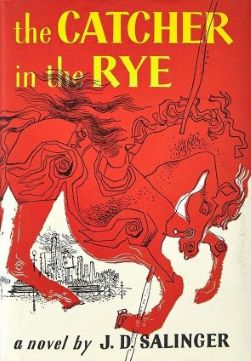How The Catcher in the Rye’s Holden Caulfield became an ally to millions.

In the 1970s, when I was a young wife and mother, we bought a house in northwest Baltimore on Ranny Road, a block-long street that ran up and down a steep hill. Many of the surrounding homes were beautiful and spacious, but on Ranny Road, they were stolid brick duplexes whose owners included a taxi driver, a hairdresser, a pharmacist, and two public-school teachers, including my husband.
The other was the father of a gangly, red-haired adolescent named Matt McGovern. Our house was in the middle of the hill, and the McGoverns’ was at the bottom. Since the street didn’t have much traffic, the children’s games frequently spilled into the road.
It was a spring evening, and I remember seeing Matt striding up from the bottom. He walked in the middle of the road and held something chest-high, clutching it with both hands as if it possessed extraordinary value.
“Hey, you guys,” he shouted to the gang at the top. “Guess what I just did.”
“What?” someone shouted back.
“I just read the best book. The best book ever.”
“What’s it called?”
Caught in the thrall of J.D. Salinger’s brilliant bildungsroman, young Matt had joined countless others whose loneliness, disaffection, and confusion mirrored 16-year-old Holden Caulfield’s. He simply had to share it with his friends.
In 1951, when The Catcher in the Rye was first published, the industry had no distinct young-adult category, so Salinger’s novel was reviewed like any other. Nash K. Burger of the New York Times called it “unusually brilliant…Holden’s mercurial changes in mood, his stubborn refusal to admit his own sensitiveness and emotions, his cheerful disregard of what is sometimes known as reality are typically and heart breakingly adolescent.”
Not all agreed: Anne L. Goodman of the New Republic considered it “disappointing, and not merely because it is a reworking of a theme that one begins to suspect must obsess the author. Holden Caulfield, the main character who tells his own story, is an extraordinary portrait, but there is too much of him.”
Whatever Goodman’s objections were, however, they did not concern Holden’s language, drinking, or encounter with a prostitute. She simply got tired of him.
Nor did the reading public initially find Salinger’s novel especially objectionable. No less an arbiter of middlebrow, middle-class American taste than the Book of the Month Club chose The Catcher in the Rye as a selection. Nearly a decade passed before the drumbeat of condemnation began.
The first recorded public reaction came in 1960, when a teacher in Tulsa, Oklahoma, was fired for including it in his curriculum. The teacher was eventually reinstated, but not Salinger’s novel. Since then, the drumbeat has been steady. For example, in 1978, it was removed from the Issaquah, Washington, optional high-school reading list; in 1986, it was banned from English classes at Freeport High School in DeFuniak Springs, Florida; and in 2001, it was removed by a school board member in Summerville, South Carolina, because it is a “filthy, filthy book.”
When I first read The Catcher in the Rye, I was about as old as Matt McGovern was on that long-ago spring evening. Like him, I found that Holden’s loneliness and depression echoed my own. (I also thought knowing Holden would be my ticket into my school’s oh-so-sophisticated clique.)
I read it again about 30 years ago because I was curious to know if the book held up. It did. Times may change, but the painful process of growing up does not. The essence of any bildungsroman is a quest the hero undertakes after suffering a loss. The death of his little brother and his flunking out of Pencey Prep precipitate Holden’s search for meaning in a world distorted by postwar ambition and materialism magnified by New York’s manic Christmastime atmosphere.
I read it a third time in preparation for this essay. And again, I was stunned. Critics Burger and Goodman were somewhat dismissive of Salinger’s use of the first person, but I found Holden’s unique, confiding tone critical to his engagement with the reader. “If you really want to hear about it, the first thing you’ll probably want to know is where I was born,” he begins. By directly addressing the reader, Holden forges a covenant with her. The writer drops away. The world drops away. What remains is an extraordinary intimacy between Holden and his listener.
At the heart of his story lies a moral decision. Having failed to connect with anyone in any meaningful way during his peregrinations through Manhattan and fearing to go home to face his father’s wrath after flunking out of another school, Holden visits his beloved little sister, Phoebe. But when she learns about his plan to hitchhike out West and begs to join him, he knows he must stop her from sliding down the rabbit hole of his own delusions. The only way he can dissuade her is by promising to return home and face the consequences of his circumstances. In the end, sad, beleaguered Holden sets aside his solipsism and takes a giant step toward maturity.
No child can escape the task time assigns her: to grow up. Fortunately for my old neighbor Matt McGovern and the book’s estimated 60 million other readers, J.D. Salinger created a friend named Holden Caulfield to guide them as they climb the steep hill to adulthood one step at a time.
Patricia Schultheis is the author of Baltimore’s Lexington Market, published by Arcadia Publishing in 2007, and of St. Bart’s Way, an award-winning story collection published by Washington Writers’ Publishing House in 2015. Her latest book is A Balanced Life, published by All Things That Matter Press in 2018.

